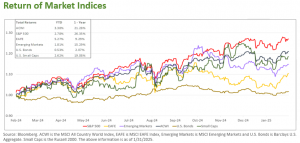What new tariffs were announced?
This past weekend, President Trump announced tariffs on 25% of nearly all Canadian and Mexican imports as well as an additional 10% tariff on Chinese goods with a planned effective date of February 4th. However, later on Monday it was announced there would be a one-month pause regarding the planned tariffs with Mexico and Canada pending further negotiations.
How did Canada, Mexico and China initially respond?
There are no one-sided trade wars, thus all three countries quickly announced plans to retaliate. Before the one-month “pause”, Mexico announced it would respond with tariffs as well as other, unspecified actions. Likewise, Canada initially announced targeted tariffs on ~$106 billion of U.S. goods, representing ~40% of its imports from the U.S.
On Tuesday, China announced 15% tariffs on U.S. coal and LNG and 10% tariffs on U.S. crude oil, agricultural machinery, large-displacement cars and pickup trucks. China has also stated that it will file a WTO (World Trade Organization) lawsuit in response to the tariffs.
Do tariffs apply to ALL incoming goods from these countries?
While tariffs may be structured to apply to all goods from a specific country, it is more common to see targeted rather than all-encompassing tariffs. There will likely be exceptions and varying rates for different industries. For instance, over 50% of the crude oil for U.S. refining is imported from Canada; to mitigate some of the impact, energy imports were set at 10% rather than the 25% tariff set on other goods. An announcement of flat across-the-board tariffs is more likely to be a starting position rather than the end point of any economic negotiation.
Are the new tariffs here to stay?
Tariffs are not set with an expiration date and trade agreements change over time. During President Trump’s earlier term, the U.S. renegotiated trade agreements with Canada and Mexico which resulted in the end of the North American Free Trade Agreement (NAFTA) which had been in place since 1994 and the adoption of the United States-Mexico-Canada Agreement (USMCA) in 2020.
Canada and Mexico are by far our biggest trading partners. For perspective, in 2023, the amount of two-way trade the U.S. had with China was only 36% of what we did with Canada and Mexico(1). In fact, the amount of two-way trade we had with Canada and Mexico was comparable to what the U.S. traded with all of Europe combined.(1)Thus, it is likely that the Canada and Mexico tariffs will change, and we will eventually see some version of a ‘USMCA 2.0’ trade deal, which would be more favorable to all parties rather than engaging in a long-term trade war.
Trade relations with other countries range between tolerant competition (ex: the Eurozone) and economic hostility (China, Russia). Thus, tariffs applied against those countries are likely to be more persistent. For example, the announced 10% tariff on Chinese goods is an increase in tariffs that were already in place.
To make long-term, durable structural changes to the U.S. economy, aligned with President Trump’s stated goal of reversing the decades-long decline in U.S. manufacturing, tariffs and trade agreements would likewise need to be long-term in nature. On-again/off-again tariffs are unlikely to result in permanent changes.
What could the impact on GDP and U.S. inflation be?
If the original planned tariffs on goods from Mexico, Canada, and China were implemented, JPMorgan estimates that these would lower U.S. economic growth by 0.5-1% in 2025 and increase inflation by the same amount. Gregory Daco, chief economist at the tax and consulting firm EY (formerly known as Ernst & Young) estimates the inflation would be 0.4% higher and U.S. growth 1.5% lower in 2025.
The impact of tariffs solely focused on China would be smaller, however it is premature to estimate the total impact of tariffs on the horizon as President Trump has said that additional tariffs will happen on goods from the European Union at some point, as well.
Traditionally, tariffs result in higher prices. For example, 81% of frozen French fries in the U.S. are sourced from Canada. So, barring a fry-related exemption, or higher costs being absorbed within the supply chain, U.S. consumers could see fry prices rise by 25%.
Why are stock markets and economists reacting poorly to the tariff announcement?
As we wrote in our November 2024 Economic Update: Tariff Talk:
“Tariffs frequently lead to trade wars, where one country levies a tariff and in response the targeted country levies a tariff in return. For instance, in response to President Trump’s tariffs on aluminum and steel, the European Union taxed a variety of U.S. products such as bourbon and Harley-Davidson motorcycles. In a similar vein, China responded to Trump’s tariffs by adding their own tariffs to soybeans and pork, which hurt American farmers.
While a targeted tariff can help protect domestic businesses against a foreign rival, in cases where there is little to no domestic production, a tariff is often inflationary and results in higher costs without a meaningful economic benefit.”
Business leaders and investors both prize predictability above all else. As uncertainty increases, both groups tend to become more cautious and wary about committing capital to a shifting landscape. Thus, investors should anticipate near-term volatility as large-scale trade negotiations unfold.
Should we change our long-term investment strategy in light of tariffs?
All projections and prognostications should be viewed cautiously, as the exact impacts of tariffs are impossible to predict with accuracy. Tariffs take an extended period to be fully felt by an economy and negotiations are ongoing.
The announcement that tariffs on Mexico would be paused resulted in an intraday reversal of some of the equity declines and serves as a good example why investors should exercise patience. Policy changes often create short-term volatility and require time to fully materialize.
The best remedy to hedge against the risks both known and unknown is to be disciplined and maintain a diversified strategy that aligns with your long-term financial goals. Resist the temptation to make sweeping changes solely based on headlines and possibilities.
Capital Markets
After equities and bonds pulled back in December, markets rebounded in January. AI-related stocks sold off at the end of the month due to concerns over U.S. dominance in the AI sector and Nvidia’s continued leadership. Even with this decline, equities had a strong month. The All-Country World Index (ACWI) rose 3.38%, the S&P 500 climbed 2.78%, developed international equities as measured by the EAFE index rose 5.27% and emerging market equities increased by 1.81%. Bonds were nearly flat but still rose 0.53%.





